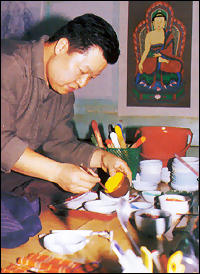|
|
|

Buddha
"Painting the Heart of Buddha" - Artist Lee Cheol-Seung
 uddhist art has flourished in Korea for over 1600 years and today,
young artists, such as Lee Cheol-Seung, continue to find inspiration in
Buddhism. Lee became interested in Buddhist art as a child when he used
to accompany his parents to the temple. For the past three years he has
been honing his talents under the instruction of Kim U-shik, another
artist know for his Buddhist works. Lee has twice received an award in
the Korean Buddhist Art Competition. The following is his presentation
of Buddhist Art.
uddhist art has flourished in Korea for over 1600 years and today,
young artists, such as Lee Cheol-Seung, continue to find inspiration in
Buddhism. Lee became interested in Buddhist art as a child when he used
to accompany his parents to the temple. For the past three years he has
been honing his talents under the instruction of Kim U-shik, another
artist know for his Buddhist works. Lee has twice received an award in
the Korean Buddhist Art Competition. The following is his presentation
of Buddhist Art.
Buddhism was introduced to Korea through China in the year 327AD. At
first Korean Buddhism was greatly influenced by Chinese Buddhism, but
has since developed into its own independent form. Temples use art, such
as statues, paintings, sculptures, and pagodas, to symbolize and inspire
faith in Buddha.
There are two distinct styles of portraits of Buddha. A painting is done
directly on the wall of a temple and is meant to depict portions of
Buddhist scripture, or a picture is done on paper or fabric, like silk
or cotton. This second type is the most common in Korean Buddhism, but
is rarely seen in Japanese or Chinese temples.
Of course Buddha was born in India, but as Buddhist art has developed
over the centuries in various countries, the portraits of Buddha have
come to resemble the people living in each country. For example, it has
been said that Chinese Buddhas look stern, Japanese Buddhas are more
artistically presented, and Korean Buddhas exude charity.
Painting a Portrait of Buddha
The first step is to refer to an original portrait of Buddha from
ancient times. From this the artist draws a general outline of the
Buddha figure and its surroundings. The artist first fills in all of the
detail around the Buddha, leaving the painting of the Buddha figure
itself until the last. In ancient times artist used paint made from all
natural materials, but these days synthetic paints are used, due to the
scarcity of the materials used in ancient paintings.
Painting the figure of Buddha, especially his facial expression, is the
most important part of the process. The artist must correctly convey the
heart of Buddha in his portrait. In order to paint Buddha well, an
artist must concentrate on painting only the Buddha for up to ten years.
This is a necessary preoccupation, which develops a high degree of
discipline in the artist. There are several famous portraits of Buddha
that may be view in Temples around Korea. The picture of Buddha,
Daewangmyeongjeon, in the temple Tongdo, and the picture of Buddha in
the temple of Jikji in Gyeongsangbuk-do Gumcheon city, are famous
pictures. You can also see an excellent picture of Buddha by visiting
Jogyesa temple (exit 2 of subway line number 2, Jong-gak station),
situated in Seoul.
(Sourced from WHAT'S ON SEOUL)
|
|
|
 uddhist art has flourished in Korea for over 1600 years and today,
young artists, such as Lee Cheol-Seung, continue to find inspiration in
Buddhism. Lee became interested in Buddhist art as a child when he used
to accompany his parents to the temple. For the past three years he has
been honing his talents under the instruction of Kim U-shik, another
artist know for his Buddhist works. Lee has twice received an award in
the Korean Buddhist Art Competition. The following is his presentation
of Buddhist Art.
uddhist art has flourished in Korea for over 1600 years and today,
young artists, such as Lee Cheol-Seung, continue to find inspiration in
Buddhism. Lee became interested in Buddhist art as a child when he used
to accompany his parents to the temple. For the past three years he has
been honing his talents under the instruction of Kim U-shik, another
artist know for his Buddhist works. Lee has twice received an award in
the Korean Buddhist Art Competition. The following is his presentation
of Buddhist Art.